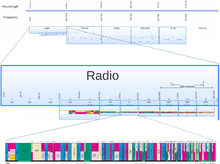Definition and Characteristics of High Frequency
- High frequency (HF) is the range of radio frequency electromagnetic waves between 3 and 30 megahertz (MHz).
- HF waves have wavelengths ranging from one to ten decameters (ten to one hundred meters).
- Frequencies immediately below HF are known as medium frequency (MF), while higher frequencies are called very high frequency (VHF).
- HF is a major part of the shortwave band of frequencies, enabling long-distance communication across continents and mountainous terrains.
- HF is used by international shortwave broadcasting stations, aviation communication, government time stations, weather stations, amateur radio, and citizens band services.
Propagation Characteristics of HF
- The dominant means of long-distance communication in HF is skywave (skip) propagation, where radio waves refract back to Earth from the ionosphere.
- Factors affecting HF communication include sunlight/darkness at transmission and reception sites, transmitter/receiver proximity to solar terminator, season, sunspot cycle, solar activity, and polar aurora.
- The usable spectrum shifts towards lower frequencies during winter nights and higher frequencies during summer days.
- Communication on HF is possible when all factors are at their optimum, allowing worldwide communication.
- Interference originating over a wide area affects many potential users of the HF bands.
Uses of HF
- Military and governmental communication systems rely on HF for secure and long-distance communication.
- Aviation uses HF for air-to-ground communications, including the international distress and calling channel.
- Amateur radio operators take advantage of HF for direct, long-distance communication.
- Shortwave international and regional broadcasting utilize HF frequencies.
- Maritime services use HF for sea-to-shore and ship-to-ship communication, including the Global Maritime Distress and Safety System (GMDSS).
Advancements and Challenges in HF Usage
- Automatic Link Establishment technology and higher speed modems have increased the usability of HF for automated connectivity, data communications, and video transmission.
- Concerns have arisen over broadband over power lines (BPL) Internet access, which interferes with HF communications due to its operating frequencies.
- Man-made interference and electronic devices, such as plasma televisions, can have a detrimental effect on the HF spectrum.
- HF communication systems are required for trans-oceanic flights in aviation.
- The upper section of HF shares characteristics with the lower part of VHF and is used for local communications, CB radios, radio links, and radio control devices.
Other Applications and Limitations of HF
- Some radio frequency identification (RFID) tags utilize HF frequencies.
- HF is known for its bandwidth-conserving nature, making it suitable for continuous wave Morse code transmissions and single sideband voice transmissions.
- Broadband modes, such as TV transmissions, are generally prohibited in the HF range due to limited spectrum space.
- Noise, especially man-made interference, has a significant effect on HF bands.
- Despite challenges, HF remains a valuable communication tool for various industries and amateur radio operators.
High frequency (HF) is the ITU designation for the range of radio frequency electromagnetic waves (radio waves) between 3 and 30 megahertz (MHz). It is also known as the decameter band or decameter wave as its wavelengths range from one to ten decameters (ten to one hundred meters). Frequencies immediately below HF are denoted medium frequency (MF), while the next band of higher frequencies is known as the very high frequency (VHF) band. The HF band is a major part of the shortwave band of frequencies, so communication at these frequencies is often called shortwave radio. Because radio waves in this band can be reflected back to Earth by the ionosphere layer in the atmosphere – a method known as "skip" or "skywave" propagation – these frequencies are suitable for long-distance communication across intercontinental distances and for mountainous terrains which prevent line-of-sight communications. The band is used by international shortwave broadcasting stations (3.95–25.82 MHz), aviation communication, government time stations, weather stations, amateur radio and citizens band services, among other uses.
Frequency range | 3 to 30 MHz |
|---|---|
Wavelength range | 100 to 10 m |

high frequency (uncountable)